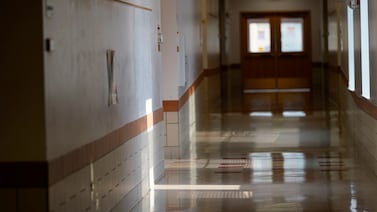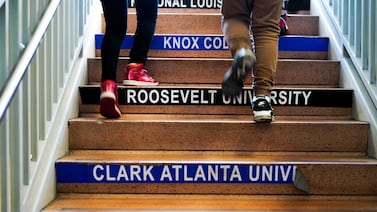Sign up for Chalkbeat Indiana’s free daily newsletter to keep up with Indianapolis Public Schools, Marion County’s township districts, and statewide education news.
The Metropolitan School District of Lawrence Township plans to revive a former middle school that was once shuttered amid declining enrollment and launch a new school with an Afrocentric focus in 2027.
Craig Prep Academy for grades 5-8 will bring back 400 students to the former Craig Middle School that closed in 2010 — one of many facility changes scheduled as the district renovates buildings districtwide and adjusts to a growing student population. Currently, the district has two 7-8 middle schools and 11 elementary schools that serve up to sixth grade.
Officials say the school, the blueprint for which the school board approved last month in a 3-1 vote, fills a community desire for a small school at the middle grades. It will also ensure the district will not have to surrender the building to charter schools under a state law that requires underutilized buildings to be made available to charters for the sale or lease price of $1.
The Afrocentric concept will serve a township where nearly half of all students, or 45%, are Black, according to the latest 2024-25 demographics presented to the board last month. Another 32% are Hispanic and 15% are white.
“When Craig closed in 2010, that really did something to the Lawrence community in terms of identity,” said Chief Academic Officer Troy Knoderer. “The commitment is about returning this building back to the community and returning this building back to a school, and having students once again back in this building.”
But the plan has sparked concern from two of the five school board members over how the school will be funded and whether enrollment will be stable in the future. They have also questioned whether the school truly fits the will of the community, which was solicited for input on the building before the pandemic.
The local teachers union has also urged the board to pause approval of the plan, noting that the school’s emphasis on African American heritage and small size would reach only a fraction of the district’s students of color.
“How is this equitable to the many students of color in our district?” Amanda Rose, co-president of the Lawrence Education Association, told the board last month. “In addition, with the set enrollment limits, this proposal is perpetuating the class size inequity we are already experiencing across the district, and that this board has committed to exploring through a district committee.”
Craig Prep to open slowly with lottery process
The old Craig Middle School building off Sunnyside Road is now known as the current Lawrence Education and Community Center, or the LECC, and houses the district’s central office and several student programs.
The district is constructing a new central office building at Fort Benjamin Harrison that it will move into in June of 2025, when renovation begins on the LECC.
Craig Prep will open in 2027 with 100 students in each of the fifth and sixth grades. The school will add another 100 seats for seventh grade in 2028 and the final 100 seats for eighth grade in 2029. At its full capacity the school will have 16 teachers, and will also share other staff with Lawrence Advance Academy.
The school’s Afrocentric elements are still in the conceptual stage, Knoderer said, but Craig Prep will follow district curriculum with supplements that focus on African and African American culture and contributions.
One example would be an integrated curriculum on ancient Egypt, the great pyramids, and geometry, Knoderer told the board at a meeting last month.
The district collected community-wide input on the future of the LECC in 2018-19 through forums and surveys, Knoderer said. The district could not provide data from the community input sessions at the time.
The school’s Afrocentric focus came from work done by a committee of community members, parents, board members, and staff in 2019-20, Knoderer said. That work included trips to schools in Kentucky and Illinois.
The Afrocentric curriculum could also fill an academic desire — at the high school level, officials say the district has seen high demand for its Advanced Placement African American studies course, which it piloted in 2022-23 and later expanded.
Officials also hope the new school will keep Lawrence competitive with private and charter schools, which they said often use a small school environment as a selling point to families.
The latest demographic data from October 2024 to October 2025 shows the district ultimately gained more students from charter schools than it lost to them, with a net gain of 161 students, excluding virtual charters, according to an analysis presented to the board last month. It lost the most to neighboring public schools districts with a net loss of 192 students, and had a net loss of 29 students to private and parochial schools.
The enrollment process for Craig Prep will be similar to the procedure used for the dual-language program at roughly a dozen schools districtwide. Families can apply for a spot in the fall of 2026. If there are more applicants than available seats, students will be selected through a randomized, computerized process known as the Choice Application Process.
The existing three student programs in the building — the Lawrence Advance Academy for high school students earning credits at a different pace than their peers, a special education program, and the Lawrence Elementary Alternative Program that serves as an alternative to suspension for elementary students — will remain there. Craig Prep will occupy the second floor, sharing the building’s two gyms and cafeteria with the other programs.
The building will also add space for students placed on home access, an alternative to expulsion. The district will also explore potentially housing adult education classes on the site through grant funding and other partnerships.
Craig Prep sparks concern on costs, equity
Financial estimates for the school are largely based around staffing, according to the district. It estimates a cost of $1 million in Craig Prep’s first year and $1.56 million in the second. Those costs do not include potential salary raises.
Board member Jessica Dunn voted against the proposal, citing concerns with funding and the new costs the district will incur when it opens its new central office building.
She also questioned whether the student population could support such a school in the future, noting the potential impact that deportation efforts from incoming President Donald Trump may have on the district’s Haitian population.
The state’s new requirement to retain students in third grade who do not pass the state’s IREAD literacy exam could also have unknown financial implications for Craig Prep, she said.
“We are relying on an increase in enrollment to do the work that we are asking the community to support,” Dunn said. “Yet we are not guaranteed that the enrollment will continue to increase.”
Board member Marta Lawrence echoed similar concerns and abstained from a vote, noting a need for more information.
But Knoderer said the district has time to work out issues that may arise.
“In the school choice environment that we have in the state of Indiana, there’s always going to be a need for another choice,” he said. “A choice that is different than what we currently have.”
Leaders of the teachers union also voiced concern about the school’s limited reach.
“Our bilingual students, students of other nationalities and ethnicities, our LGBTQ students, just to name a few other subgroups, equally deserve to learn from a curriculum that celebrates their identity and allows them to explore the roots of their respective cultures,” union co-president Eric Marty told the board before its vote last month.
All students are exposed to a culturally responsive curriculum, Knoderer said.
“Craig Prep would be very specific around an Afrocentric approach,” he said. “Some of that you would see in other schools as well, but not the immersive type of experience that is envisioned at this point. That really would be by family choice.”
Regarding concerns about unfair class sizes, Knoderer said Craig Prep’s class size would be about 25 students per teacher, similar to the rest of the district. Students would instead benefit from a small overall school environment, he said.
Board member Crystal Puckett voted in favor of the school, noting that as the mother of a young Black man she understands the importance of representation.
“I know I was a mother that looked at other schools for my child because I wanted my son to have a smaller environment,” she said at the meeting last month. “I wanted him to have an environment where he had a cultural awareness.”
Amelia Pak-Harvey covers Indianapolis and Lawrence Township schools for Chalkbeat Indiana. Contact Amelia at apak-harvey@chalkbeat.org





